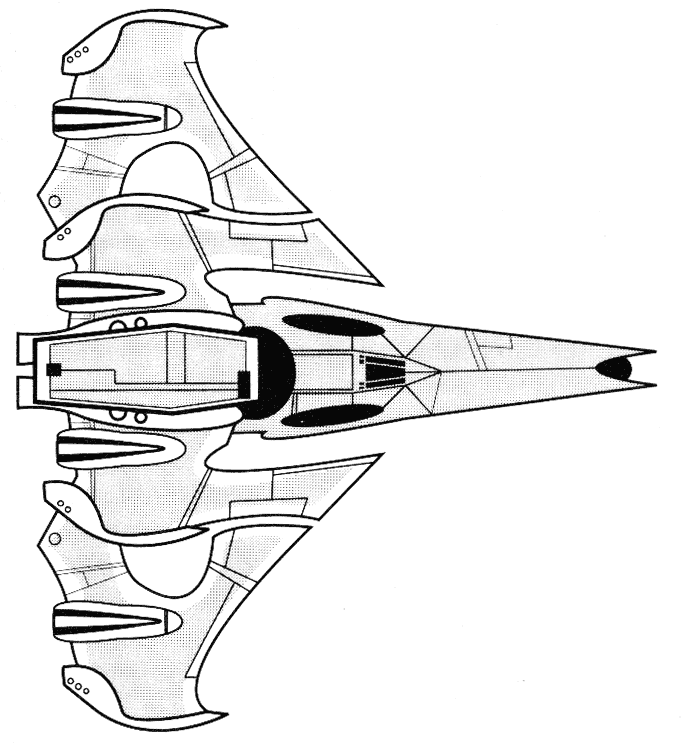
|
The Helix Light Interceptor was publicly claimed to be a freighter, even though its weapons load-out was obviously illegal for a ship of its size. It remains a mystery as to how Arakyd persuaded the Bureau of Ship Services (BoSS) to regard the Helix as a transport craft. BoSS realized the severe error that it had made six months after the first Helix was delivered. As a result, an Imperial mandate was issued which barred further production of this craft or modified design types of this craft. Unwilling to risk the Empire's wrath, Arakyd complied with the dictate, but not before thousands of Helixes were shipped. This ship was off the market at least since the SSD Executor was commissioned. Two models of the Helix were released by Arakyd. Beyond the different hyperdrive and negligible configuration options, the models are practically the same.
Even though the Helix is classified as a freighter, its cargo section is too small and its life support reserves are the lowest in the freighter classification. And due to this, its consumables would have to be restocked well before its fuel cells run dry (assuming a normal power load for freighter operations). Nevertheless, its defensive and offensive capabilities are awesome. Because of the Helix's obscene cost and complicated systems, it was out of reach to most independent spacers. On the other hand, those able to afford this extremely rare ship can sleep comfortably that they will be able to make good on almost any contract. It is known that criminals also employ this craft.
Not only did the Imperial mandate bar this craft's manufacture, it also called for its owners to register their ships with the ISB, and to also modify their ships to meet Safe Starship Regulations. These alterations called for, but not limited to: removing half the weapons and downgrading the shield generator to a Mark I equivalent. A wide variety of Helix owners, as most starship professionals predicted, blatantly ignored the Imperial mandate. Because of this most Imperial personnel are suspicious of any Helix they come across. And as a result most have the ship inspected on the spot, and demand that all datawork and declarations be in perfect order. Not unexpectedly, the starship black market, and other treasonous parties, have created a substantial industry selling forged documents for the Helix and similar ships. On the other hand, Imperial nobles who own this exotic ship are not questioned on the matter.
The two laser cannons which are placed amidships (on either side of the cockpit module) can have their fire-link option de-activated to allow the cannons to fire at separate targets. Due to the cannons' placement clear fields of fire are possible from the Helix's ventral arc, thereby allowing this craft to offer ground-fire support. Meanwhile, the Helix's ion cannons discharge rate is comparable to military grade weapons. At the most dorsal position on the starframe, directly amidships is the proton torpedo launcher.
Manoeuvrability in vacuum is emphasized by the Helix's superstructure. Located along each of the six trusses that run half the length of the ship are its thruster banks. Although they noticeably project from the primary fuselage, they were not a afterthought as might be pondered by the average citizen. By placing the thruster banks as far from the craft's centre of momentum as possible, individual thrusters have a greater effect on turning acceleration. A consequence however, is that the relatively weak hull trusses are easily damaged in an atmospheric situation. Further compounding this problem is that the trusses are difficult to reinforce. The Helix's flight control computer artificially sets its flight capabilities below its rated atmospheric envelope while the ship is in an environment of 0.4 standard atmospheres or greater to ensure safe operation. This artificial envelope can be overridden in a predicament, it is likely however, that the manoeuvrability jet supports will tear apart as they are assaulted by the atmosphere.
The hull plating of this "freighter" can withstand up to 75 Gs without alluvial dampening effects. Mounted along the transverse of the wings, arranged in a staggered dorsal-ventral configuration for maximum manoeuvrability are the Helix's primary ion drives. Heat and emission baffling for the engines were not included in the design as Arakyd engineers surmised that the Helix's already strong energy signature would negate the effect of such gestures. Since this craft gives off a very substantial sensor return, surveillance station operators have little to no trouble in tracking Helixes as soon as they appear in their respective star systems.
| Pictures For This Data Entry - Click Here |